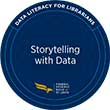Data Literacy for Librarians Digital Badge Program
This digital badge program focuses on seven foundational data literacy competencies and uses FRED® data to provide opportunities for hands-on learning.
Each topic in the program (listed below) is matched to a digital badge issued by Credly. Librarians who successfully complete individual modules will receive, at no cost, Credly badges certifying their achievement. After completing all seven individual modules, librarians will receive a digital micro-credential: Data Literacy for Librarians.
Learn more about all our digital badges and how they can help with professional development.
-

Saving Graphs and Downloading Data
Finding and visualizing the data you need for a project is time-consuming. Knowing how to save your work and selecting the format appropriate for your project will help you access, share, and make further use of your data.
-

Identifying Data Sources and Release Frequencies
Understanding how data are collected and revised is important to use them correctly. Also, the difference between open and proprietary sources determines how data can be redistributed. Knowing how to identify the open or proprietary character of a data source and the method used to collect, release, and revise the data will help you think critically about your data.
-

Understanding Data Types and Units
Understanding what the data represent and how that concept is measured is important to use them correctly. Also, identifying and understanding the units of measurement and the methodologies employed to estimate and report statistical observations will help you select the data appropriate to your purposes.
-

Visualizing Data
Creating data visualizations helps identify key takeaways in quantitative information. Data graphs are practical instruments of exploratory analysis showing trends, relative sizes, and correlations in data sets. Accurately designing and correctly interpreting data plots are preliminary steps for effectively communicating with data.
-

Storytelling with Data
Concisely describing data helps communicate the key features of quantitative information and connect those features to persuasive arguments. Clearly explaining what the data are and placing them in a relatable context make quantitative analysis accessible to diverse audiences.
-

Acting on Data
Making choices using quantitative information requires numeracy competencies and skills. Although those can be both very broad and very deep, a baseline competency conducting exploratory analysis using data visualizations provides a good foundation from where you can undertake practical courses of action.
-

Using Data Ethically
Users of data must adopt ethical practices when gathering, analyzing, and sharing data. Unethical data practices undermine the end-uses of quantitative information. The principles of data ethics apply to all stages of data-related work, from collection to citation.
---
If you have difficulty accessing this content due to a disability, please contact us at economiceducation@stls.frb.org or call the St. Louis Fed at 314-444-8444 and ask for Economic Education.
Find More Economics and Personal Finance Teaching Resources
Subjects: STEM , Data Literacy
Resource Types: Lesson , Tutorial , Instructional Guide , Data , Digital Badge
Languages: English

